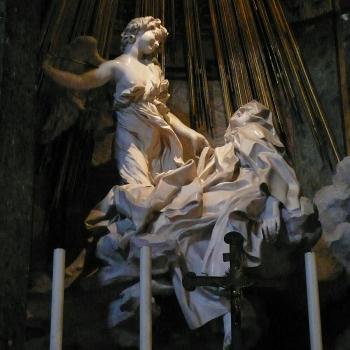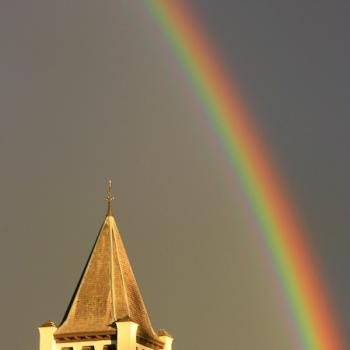Alongside the Crucifixion, the Eucharist–and specifically the Real Presence, the literal transformation of the bread and wine into the Body and Blood of Christ–was one of the aspects of Catholicism which first drew me to the faith. I could tell you that it was because the Catholic doctrine seemed most responsive to the Gospels; I wrote a paper, back when I was the only atheist in my History of Christian Doctrine section, arguing that Jesus’ words at the Last Supper, when you consider His insistence in the face of horrified disbelief in John 6:52 – 57, wasn’t simply a metaphor like “I am the vine.” But I have to admit that I loved (and love!) the doctrine of the Real Presence largely because it’s visceral, bizarre, bloody-minded. It seems like the kind of overturning, catastrophic, violent thing the God of Exodus and Good Friday would do–the kind of awful thing our world and our actions would require of Love. It is hardcore.
When I was sick with stress and unsure if I’d really go through with baptism and confirmation, Eucharistic Adoration steadied me and got me through it. I’ve found Adoration deeply consoling, especially because you don’t have to worry about whether you’re able to receive Communion. Nothing’s required of you except your presence. There’s nothing you have to pray or do–just be there. The Mass is the corporate prayer of the Church but there are times when you want an intimacy, a bridal chamber for yourself and Christ, without dealing with your neighbor or your place in the community. Venturing into extreme anecdata, I’ve written a bit about the atttraction the Eucharist holds for those on the margins of the Church due to poverty or stigmatized sexuality.
So I picked up Miri Rubin’s study Corpus Christi: The Eucharist in Late Medieval Culture with great interest this Lent. I’ve gnawed through this tome 20pp at a time and found a great deal to love in it, despite some disagreements with her framing of the issues. Rubin delves deep into all kinds of records and evidence–not only theology and hagiography but wills, church financial records, the annotations and marginal illustrations in prayerbooks; parody, superstition, miracle tales, and more. I loved her willingness to seek out everybody’s responses to the Eucharist, not just the “official” ones. I loved her attention to the ways that people use even our most meaningful cultural touchstones–no, actually, especially our most meaningful cultural touchstones–for a variety of all-too-human purposes, economic and political and emotional. One of Rubin’s theses is that the Eucharist grew steadily in cultural presence, and Eucharistic piety rose to a fever pitch, throughout the second half of the Middle Ages–but that this piety called forth responses, criticisms, heresies. Every doctrine gives people a vocabulary with which to articulate their resistance to it, or to the people who promote it.
Rubin begins with the stuff I find hardest to grasp: the theology of transubstantiation, the use of philosophical categories to try to articulate just what happens at the consecration. This vocabulary of substance and accidents is trying to outline an important thing. It’s an attempt to honor both the miracle of the Body and Blood, and the sensory evidence of the bread and wine–an attempt to hold both extremes in one hand. But in the end I like St. Thomas Aquinas best when he’s hymning the Eucharist, not defining its mechanisms:
That which you do not understand,
That which you do not see,
Faith will strengthen
Beyond the order of things.
Rubin gives you the sensory world of the medieval Eucharist: the bread for hosts baked in “total silence but for the recitation of psalms”; the sacring bell, the incense. She gives you lovely English prayers, greeting Jesus with “Welcome!” or “Hail!”, for the elevation of the Host (which itself developed during this period and became increasingly important to lay piety–hold on, let me replace the thorns with “th”):
Welcome, lorde, in fourme of brede
For me thou sufferde herd deede;
Also thou bore the crowne of thorne
Thou suffer me noghte be forlorne.
And, because medieval people are always extra, here’s the 1502 will of Thomas Goisman of Hull: “I bequeath… in honour of the sacrament, to make [a machine] which will rise and descend at the high altar, as angels go up and down, between the elevation of Christ’s body and blood, and the end of the chant, Ne nos inducas in temptacionem.” This particular innovation did not catch on.
Rubin often says that the Eucharist was “designed” in the later Middle Ages–and designed, she heavily implies, in order to strengthen the power of clergy over laity. This is the one area where she does not always see polysemy or alternative understandings; and I don’t think she proves a case that Eucharistic fervor creates clerical supremacy. Rubin may be reacting against Caroline Walker Bynum’s work; she suggests that Bynum overemphasizes Eucharistic piety as women’s spirituality. But it seems clear that Eucharistic piety and Eucharistic visions did in fact provide women with a source of authority of their own: “[E]ucharistic miracles [involving women] were more plentiful and more intense than those of men. Two types of experience were associated particularly with women: seeing a child in the host, and living on the host alone. Religious women, Cistercian nuns, and especially the beguines were particularly susceptible to eucharistic visions, and especially to being given communion directly by Christ.” “Agnes of Montepulciano (d. 1317) and Margaret of Faenza (d. 1330) were each so intoxicated with the baby they saw [in the host] that they refused to give it up, and Ida of Louvain played with the child revealed to her.” Women’s Eucharistic miracles “often centre on questions of authority, the women being blessed by communion which obviates parochial routine and its limitations,” as when “an angel celebrat[ed] mass for a lady in the absence of her chaplain.”
There’s certainly evidence for Rubin’s position. Only a priest could consecrate the Eucharist. Rubin notes, as an example of the Eucharist becoming “more clearly the preserve of the clergy,” that “Throughout the twelfth century the chalice was removed from lay communion.” Priests heard confessions and thus prepared people to receive Communion. It’s not necessarily clear how often people received in these centuries, but Rubin uses a range of evidence to suggest that laypeople communicated pretty rarely, and it’s quite plausible that people often refrained from communion specifically because they believed they were not in a proper state to receive.
But interestingly (to me, as a Graham Greene-esque sleazoid and general sinner), laypeople developed forms of Eucharistic piety which allowed them to worship even when they couldn’t receive. They ate the blessed bread distributed at the end of the Mass; they passed this weird thing, “the pax,” an object you kiss. Elevation of the Host allowed people to view the Eucharist even when they couldn’t receive, and even cities under interdict demanded the exposition of the Host as their right.
Rubin, describing late-medieval heresies, writes, “The critique of the eucharist was an attack at its weakest points: where it claimed to conjure God under the guise of matter, where it claimed that this could even by done by a priest who was a sinner, and in its claim that no amount of virtue could free a person from dependence on the mediating sacramental channels.” For me these are among the strongest points of the Catholic claim: God coming to us physically, because the body is beautiful and made for union; God’s rescue coming even when we sin, even when we are betrayed by sinful leaders; God’s rescue coming because we can’t rescue ourselves, as any fule kno. (The latter two aspects of the Eucharist render subordinate the claims of all human authorities, including priests and people believed to be holy.)
Rubin gives you the most charming effervescences of Eucharistic piety: “A ubiquitous exemplum tells of the woman who stole the host after communion to fructify her bees: she put it in the hive, only to find when she returned to check the results that the bees had erected an ‘ecclesiula’ in its honour and were venerating it.” She explores the proliferation of Old Testament prefigurations of the Eucharist, including the Sacrifice of Isaac and also his circumcision, and a traditional scene of “David kneeling in the wilderness, raising his hands with which he offered his soul, in the form of a swaddled baby, to the Godhead peering from a cloud.”
But the more you read Christian history the more you find that nothing you love is safe from misuse. Nothing you love is safe from weaponization–most commonly against the Jews. Earlier in the Middle Ages, Rubin says, Jews appeared in Eucharistic miracle tales as simple unbelievers converted by visions of a child (or other representation of Christ, such as a lamb, raw flesh, or the suffering Jesus) in the Host. But as the centuries wore on toward modernity the Jews of the Christian imagination became more vicious, attacking the Host before being miraculously punished. In one tale Jews attack a host and it bleeds; “the Jew was led to execution, the miraculous host was revered, a chapel built in its honour, and processions, hymns and memorials created for it.” The wall paintings in a Lincolnshire church included: “the Israelites gathering manna, the marriage in Cana, the story of the laughing woman in St Gregory’s mass, and a tale of the desecration of a host by a Jew.” An English Corpus Christi sermon includes the tale of a Christian and a Jew who “enter a church, and only the Jew is visited with a vision of the bleeding Christ in the hands of Christians. To the question why only he could see it the answer is given [I’ve changed the obsolete letters e.g. thorns]:
And thy kun [=kin] made hym dye,
Therfore al blodi thou hym seye.”
The celebration at the heart of Rubin’s book, the new medieval feast of Corpus Christi, exemplifies the exuberant beauty of medieval piety–and the ways in which that piety could become commercial or cruel.
The feast began with a vision in Liege, a center of beguine life. “Juliana, a famous saintly woman who served at the leper-hospital,” had a vision of “a full moon, a segment of which was darkened by a blemish.” This blemish, Jesus told her, was the missing feast in the Church’s calendar: the feast of His Body and Blood. Various authorities considered Juliana’s vision, including Dominicans and the chancellor of the University of Paris, and made no objections. The feast fell in and out of favor with clerics, even after Pope Urban IV, who came from the region, got into it. (One of the first people he told when he elevated the feast to universal observance was St. Juliana’s friend Eve, also a beguine, heart emoji BFF emoji.) Urban IV argued “that Corpus Christi was to be a sort of obverse of Maundy Thursday, celebrating the day of the institution of the eucharist not in sorrow in the Passion week, but on another, joyful occasion.” It spread through religious orders (Cistercians, Dominicans) and between cities with trading ties, before at last spreading throughout the Church in the fourteenth century.
The Corpus Christi liturgy uses “Christmas collects as well as benedictions from Easter week.” In England it was (supposed to be) a day to “do penance and give alms”; the cathedral in Zurich distributed charity on this day. Processions with monstrances under canopies arose, influenced by the processions to the housebound with the viaticum (I think this is the scene at the end of Visconti’s Leopard) and by Palm Sunday processions. There were banners and flags, candles, hymns, reliquaries, copes, garlands of roses; sometimes children scattering flowers on the processional route; “in Spain dancers, sometimes dressed as angels”; floats and eventually full plays, including play cycles which could take several days to perform. One Corpus Christi play covered Old Testament prefigurations of the Eucharist, its institution at the Last Supper, and a whole passel of theological discussion “including figures such as Peter Lombard and Thomas Aquinas.” And over one hundred lights! These plays occasionally interspersing serious Biblical tales with slapstick or low comedy. There were several bad-Jew plays, because of course. Rubin notes, “On the Continent the presence of Jews helped produce embellishment of the scenes with words in Yiddish and distinctive Jewish costumes.” And IRL Jews were accused of refusing to kneel to the Eucharist in procession, or muttering “injurious words in Hebrew” as the procession passed by.
To produce all this glitz Corpus Christi fraternities of laypeople (kind of K of C or lodge-type associations) arose, which were also often responsible for taking the viaticum to the sick. One of them had a ceremonial drinking horn which btw I also want. The processional became “a hierarchical display [which] spoke an idiom of privilege and lordship.” The most prestigious fraternities and guilds marched closest to the Eucharist. The Corpus Christi fraternity was sometimes a “junior patrician group,” a training ground for future leaders; other times it was a “representation of the town council” which engaged in “correction and disciplining of the elected town officers.” These groups were “an extension of the group which ran the town on a daily basis.” The use of the procession to represent temporal power led to squabbles over precedence; the big summer feast, with all its pageantry and out-of-town spectators, drew plenty of customers for prostitutes.
The canopies used by kings in their own processions are mimicking these eucharistic canopies! (Remember how I said the Corpus Christi procession in The Radetzky March was so thoroughly a celebration of the Dual Monarchy that the sacrament never even appeared?) “The hierarchies which the eucharist marked within the public sphere enabled, if not forced, an identification of order and a disposition of power, and in so doing it also suggested the critique of this order.”
Rubin draws out the connection between critique of the social order and disbelief in the Real Presence: “If sacramental bread were like any other bread, then the priestly function, the particular sacerdotal efficacy which justified priestly privilege, and ultimately the whole ecclesiastical structure, was put into question.” She adds: “Lollards could describe the poor as ‘quicke images of God’, whereas they would not accept the consecrated bread as so closely bound to Him.”
I’m always about public displays of Catholic beauty–except that in a Catholic-ruled culture, such displays so often become ways of humiliating non-Catholics. In her conclusion Rubin flashes forward to the Reformation, when Corpus Christi in Catholic lands could become an occasion for clashes between the Catholic procession and the Protestants who refused to hang banners. “In Lyon in 1561,” she notes without comment, “Catholics shouted: ‘For the flesh of God we must kill all the Huguenots.'”
I can’t find it, so maybe I’m misremembering, but doesn’t Chesterton have some catty line like, “The man who says he disbelieves in the doctrine of the Trinity most often says so because he wants to sleep with his neighbor’s wife”? [ETA: Chesterton vindicated! Apparently he did not say this at all.] Rubin’s book suggests, to this little black duck, that the hidden motive of the man who says he disbelieves in the Real Presence in the Eucharist, or the necessity of the priest’s consecration, is more likely to be mistreatment by powerful Catholics.
I expected this book to be good Lenten reading. I did not expect–though I should have–that it would be so relevant to this specific Lent.
Monstrance via Pixabay.











